
Eternit is a registered trademark for a brand of fibre cement currently owned by the Belgian company Etex. [1] Fibre is often applied in building and construction materials, mainly in roofing and facade products.

Eternit is a registered trademark for a brand of fibre cement currently owned by the Belgian company Etex. [1] Fibre is often applied in building and construction materials, mainly in roofing and facade products.

The term "cement" originates from the Latin word "Caementum", which signifies chopped stone. Cement describes a binding substance, which will react chemically with water and develop into a material as hard as stone. In fibre cement, there is a fibre reinforcement, which contributes to making the fibre-cement material even stronger and to better withstand tension. Together with a carefully planned production process, fibre cement makes it possible to develop strong and long-lasting construction materials. [2]
Today fibre cement is considered a material physically suited for construction products such as cladding and roofing. [3]

Fibre-reinforced cement products were invented in the late 19th century by the Austrian Ludwig Hatschek. Principally he mixed 90% Portland cement and 10% asbestos fibres with water and ran it through a cardboard machine. Originally, the fibres were of asbestos and the material was commonly used as siding in house buildings due to its low cost, fire-resistance, water tightness, lightweight, and other useful properties. Asbestos turned out to be harmful to health and produces mesothelioma, a form of lung cancer, years after professional or occasional exposure (asbestosis). Starting from the seventies, asbestos use became progressively prohibited; however, in several countries, it is still used for building materials. Safer fibre alternatives, based on e.g. cellulose fibers were developed in the eighties and applied to secure the widely known strength of fibre cement.
In countries where asbestos use has been phased out, fibre cement was among the last remaining asbestos-containing materials on the market.[ citation needed ] The reason is that the asbestos fibres are intimately bound to the cement matrix and were first considered to be well immobilized in the cement and less prone to be released in the environment, suspended in the air, and inhaled in the lung than in other materials or applications such as thermal insulation or flocking in which bare asbestos fibres were used. However, asbestos fibres are inevitably released during machining operations of the objects made of fibre-cement and by long-term erosion of the materials exposed to atmospheric weathering and wind when cement degrades. Occupational health concerns and the protection of workers in the fibre-cement factories have finally led to the progressive elimination of asbestos from these products. [2] For health reasons, it is recommended that existing fibre-cement products that are in good condition are left undisturbed and possibly encapsulated, to prevent fibre release. [4]
Fibre cement is a main component of long-lasting building materials. The main application areas are roofing and cladding. The list below gives some common applications.
Internal cladding:
External cladding:
Roofing:
Fibre-cement products have found wide usage in various sectors of construction: industrial, agricultural, domestic and residential buildings, mainly in roofing and cladding applications, for new constructions and refurbishment projects.

A roof is the top covering of a building, including all materials and constructions necessary to support it on the walls of the building or on uprights, providing protection against rain, snow, sunlight, extremes of temperature, and wind. A roof is part of the building envelope.

Chrysotile or white asbestos is the most commonly encountered form of asbestos, accounting for approximately 95% of the asbestos in the United States and a similar proportion in other countries. It is a soft, fibrous silicate mineral in the serpentine subgroup of phyllosilicates; as such, it is distinct from other asbestiform minerals in the amphibole group. Its idealized chemical formula is Mg3(Si2O5)(OH)4. The material has physical properties which make it desirable for inclusion in building materials, but poses serious health risks when dispersed into air and inhaled.
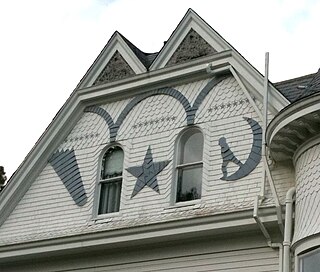
Siding or wall cladding is the protective material attached to the exterior side of a wall of a house or other building. Along with the roof, it forms the first line of defense against the elements, most importantly sun, rain/snow, heat and cold, thus creating a stable, more comfortable environment on the interior side. The siding material and style also can enhance or detract from the building's beauty. There is a wide and expanding variety of materials to side with, both natural and artificial, each with its own benefits and drawbacks. Masonry walls as such do not require siding, but any wall can be sided. Walls that are internally framed, whether with wood, or steel I-beams, however, must always be sided.

Transite originated as a brand that Johns Manville, an American company, created in 1929 for a line of asbestos-cement products, including boards and pipes. In time it became a generic term for other companies' similar asbestos-cement products, and later an even more generic term for a hard, fireproof composite material, fibre cement boards, typically used in wall construction. It can also be found in insulation, siding, roof gutters, and cement wallboard. The more prevalent transite found in wall construction and roofing tiles for example, will last anywhere from 50 years to over 100 years.

Asbestos cement, genericized as fibro, fibrolite, or AC sheet, is a composite building material consisting of cement and asbestos fibres pressed into thin rigid sheets and other shapes.

Fiber cement siding is a building material used to cover the exterior of a building in both commercial and domestic applications. Fiber cement is a composite material made of cement reinforced with cellulose fibers. Originally, asbestos was used as the reinforcing material but, due to safety concerns, that was replaced by cellulose in the 1980s. Fiber cement board may come pre-painted or pre-stained or can be done so after its installation.
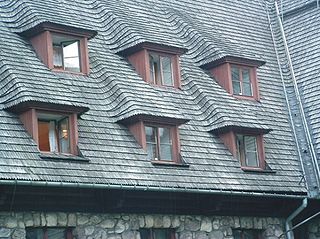
Roof shingles are a roof covering consisting of individual overlapping elements. These elements are typically flat, rectangular shapes laid in courses from the bottom edge of the roof up, with each successive course overlapping the joints below. Shingles are held by the roof rafters and are made of various materials such as wood, slate, flagstone, metal, plastic, and composite materials such as fibre cement and asphalt shingles. Ceramic roof tiles, which still dominate in Europe and some parts of Asia, are still usually called tiles. Roof shingles may deteriorate faster and need to repel more water than wall shingles. They are a very common roofing material in the United States.

Stone veneer is a thin layer of any stone used as decorative facing material that is not meant to be load bearing. Stone cladding is a stone veneer, or simulated stone, applied to a building or other structure made of a material other than stone. Stone cladding is sometimes applied to concrete and steel buildings as part of their original architectural design.

David Fleay Wildlife Park is a heritage-listed wildlife park at Fleays Wildlife Park Conservation Park, Tallebudgera Creek Road, Tallebudgera, Queensland, Australia. It was built from 1952 to 1983. It is also known as Fleays Wildlife Park. It was added to the Queensland Heritage Register on 23 February 2001.

Bituminous waterproofing systems are designed to protect residential and commercial buildings. Bitumen is a material made up of organic liquids that are highly sticky, viscous, and waterproof. Systems incorporating bituminous-based substrates are sometimes used to construct roofs, in the form of "roofing felt" or "roll roofing" products.

Asbestos is a naturally occurring fibrous silicate mineral. There are six types, all of which are composed of long and thin fibrous crystals, each fibre being composed of many microscopic "fibrils" that can be released into the atmosphere by abrasion and other processes. Inhalation of asbestos fibres can lead to various dangerous lung conditions, including mesothelioma, asbestosis, and lung cancer. As a result of these health effects, asbestos is considered a serious health and safety hazard.

Asphalt roll roofing or membrane is a roofing material commonly used for buildings that feature a low sloped roof pitch in North America. The material is based on the same materials used in asphalt shingles; an organic felt or fiberglass mat, saturated with asphalt, and faced with granular stone aggregate. The installation process, known as Torch On Roofing, is often used on commercial properties in North America.
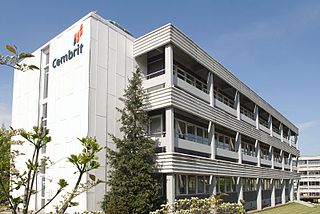
Cembrit is a distributor and manufacturer of fibre-cement products in Europe and offers a range of fibre-cement based products for roofing, interior cladding and exterior cladding.
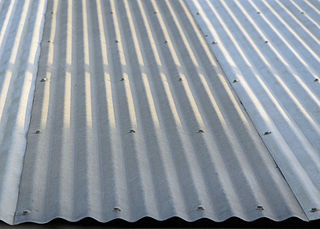
Fibre cement is a composite building and construction material, used mainly in roofing and facade products because of its strength and durability. One common use is in fiber cement siding on buildings.
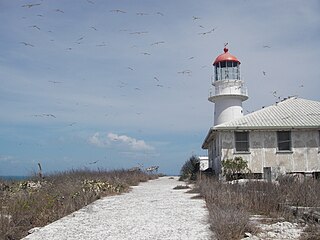
Booby Island Light is an active heritage-listed lighthouse located on Booby Island in the Shire of Torres, near the tip of Cape York Peninsula, west of Prince of Wales Island, within the Endeavour Strait, Queensland, Australia. It marks the western entrance to the navigation channel through the Torres Strait. It was the last of the major lights to be constructed along the Queensland coast.

Copper has earned a respected place in the related fields of architecture, building construction, and interior design. From cathedrals to castles and from homes to offices, copper is used for a variety of architectural elements, including roofs, flashings, gutters, downspouts, domes, spires, vaults, wall cladding, and building expansion joints.
Nigerite Limited is a firm that manufactures roofing and ceiling sheets and provides building components to the construction and building industry in Nigeria. It was established in April 1959 as a joint venture between the Western Regional government, Eternit Group who had majority shareholding, Patterson Zochonis and John Holt.
Bungalow 702 is a heritage-listed house at Lam Lok Loh, Drumsite, Christmas Island, Australia. It was added to the Australian Commonwealth Heritage List on 22 June 2004.

Ludwig Hatschek was an Austrian industrialist. He was the founder of the Eternit-Werke factory in Vöcklabruck, Upper Austria.